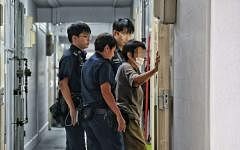On 2nd August, the U.S. State Department announced to the media the schedule and purpose of Secretary of State Rex Tillerson’s inaugural visit to Southeast Asia. This visit marked Tillerson’s second official group meeting with the foreign ministers of ASEAN after the special U.S.-ASEAN Foreign Ministers Meeting held in early May.
In the upcoming meeting, the main topics of discussion will include North Korea’s nuclear programme, security in the South China Sea and counterterrorism. At the same time, Tillerson could reaffirm the U.S. policy of contact and appeasement as well as its implementation in Southeast Asia, while Southeast Asian countries express their expectation and disappointment in the certainty of the Trump administration’s Southeast Asia policy. This suggests that Tillerson’s first visit to Southeast Asia is unlikely to change the general state of the trilateral relations between China, ASEAN and the U.S.
Tillerson’s visit emphasises “appeasement”
2017 marks the 40th anniversary of U.S.-ASEAN dialogue relations. However, it seemed that the bilateral relations have unfortunately once again sunk into an awkward predicament like the one 10 years ago. 2007 saw the commemoration of the 30th anniversary of U.S.-ASEAN relations. That year, the U.S.-ASEAN Summit, which both parties had been busy preparing for, was cancelled due to issues over security and the issue of Burmese leaders participation in the summit. As a result, the then-leaders of ASEAN were extremely dissatisfied with the U.S. Even though is it is much difficult for the U.S. to again implement its “well-meaning indifference” policy on the Southeast Asia region today, multiple rifts between the U.S. and ASEAN countries have emerged before and after the Trump administration took office.
On the one hand, Southeast Asian countries do not accept the continuing lack of certainty in the Trump administration’s Southeast Asia policy. When Trump first took office, Southeast Asian countries were relatively uneasy about the U.S.’ lack of a consistent Asia-Pacific and Southeast Asia policy. This sense of unease was evident at the annual unofficial U.S.-ASEAN Foreign Ministers’ Meeting. Furthermore, as the result of the recent instability of the Trump administration’s internal organization structure, some outside observers even doubt if the U.S. Secretary of State Tillerson, Defence Secretary James Mattis and other officials will remain in office for long. Hence, the worry and unease of ASEAN countries remain undiminished.
On the other hand, a heated discussion on “whether Duterteism is engulfing Southeast Asia” emerged in the second half of 2016 as Southeast Asian countries such as the Philippines, Malaysia and Thailand enhanced their practical cooperation with China. This also revealed the numerous rifts between the U.S. and Southeast Asian countries such as the Philippines, Thailand and Malaysia. Under the profound influence of the lack of certainty in the Trump administration’s Southeast Asia policy, the relations between the U.S. and the Philippines, Thailand as well as Malaysia have yet to be repaired.
However, current signs point to the fact that the awkward predicament seen 10 years ago is unlikely to play out again under the dialogue mechanism adopted by the foreign ministers and leaders of the U.S. and ASEAN. To summarise Tillerson’s Southeast Asia visit, there are simply two aims: one is to continue the U.S.’ policy of contact and appeasement towards Southeast Asia, the other is to lay the groundwork for Trump’s inaugural visit to the Philippines as well as his participation in the APEC Economic Leaders' Meeting and East Asia Summit.
Undoubtedly, this visit was significant in demonstrating that the U.S. emphasises the importance of Southeast Asia and makes efforts in partially improving its relations with countries such as the Philippines and Thailand. However, mere contact and appeasement or a “cursory” emphasis might not be in line with Southeast Asian countries’ expectation that the U.S. lays out a clear regional policy.
With regard to the situation in the Southeast Asian region, the U.S.’ Southeast Asia policy is subordinate to its China policy. As the axis of the U.S.-Asia Pacific policy, the U.S.’ current China policy remains largely at the stage of exploration, contact and experiment. Hence, it is presently difficult to pin down the U.S.’ Southeast Asia policy.
ASEAN focuses on building a “Community”
Against such a backdrop, ASEAN countries, which usually emphasise its “centrality” and depend on certainty in managing regional affairs, can only focus on the current, collective development of a “Community” as well as the increasing practical dialogue and cooperation between China and ASEAN countries. Thus, ASEAN’s foreign diplomacy under the leadership of “Duterteism”, which is marked by an emphasis on independent and practical diplomacy, can be considered as in line with the current state of the “China-ASEAN-U.S.” trilateral relations and ASEAN’s advocacy of a need to consolidate its “centrality” in regional affairs.
The “China-ASEAN-U.S.” relations remain one of the most important relations in the Southeast Asian region. Within this context, the contest and rivalry between China and the U.S. is a determining factor, while ASEAN is a fundamental factor. At present, the “China-ASEAN-U.S.” relations are no longer as straightforward as ASEAN countries being economically dependent on China and reliant on the U.S. for their security. Instead, the relations are interdependent and complex.
Whether China is more economically reliant on ASEAN countries or vice versa remains a topic that deserves to be delved into more deeply. Both parties are presently devoting their efforts to forging practical dialogues and economic cooperation, while focusing on jointly developing the 21st-century Maritime Silk Road and negotiating the RECP. In terms of security, Southeast Asian countries including the Philippines, Thailand, Malaysia and Myanmar are gradually becoming more accepting towards China, as seen in their procurement of weapons from China and the establishment of regular security dialogues and cooperation with China. The conclusion of the Code of Conduct in the South China Sea suggests that the South China Sea security dialogue between China and ASEAN countries has achieved significant progress.
In contrast, the Trump administration lacks a clear and consistent regional policy, and its security relations with Southeast Asian countries such as the Philippines, Thailand and Cambodia are regressing, with the U.S.-Philippines relations being a case in point. Economically, the Trump administration has “ditched” the TPP that includes four Southeast Asian countries, namely Singapore, Malaysia, Vietnam and Brunei, but has failed to propose a clear replacement. On the contrary, the Trump administration is currently taking a “conservative” stand in global economic cooperation, which has worried some Southeast Asian countries.
With regard to ASEAN, while it currently remains a fundamental factor in regional and international politics, it does not want its fate to be dictated by others as it gradually realises that the China-U.S. contest and any imbalance of the situation are threatening regional security. In an attempt to take its fate into its own hands, ASEAN has proposed to enhance the “certainty” of an otherwise uncertain regional and international environment by strengthening the development of a “Community” and consolidating its “centrality” in regional affairs. This is precisely a topic that should continue to be considered and deliberated on after the ASEAN countries have commemorated the 50th anniversary of the grouping’s establishment this year.
Besides continuing to carry out the “Freedom of Navigation Operations” in the South China Sea, the U.S. has not placed the kind of emphasis on Southeast Asia that the Obama administration did, whereas both Tillerson’s inaugural visit to Southeast Asia and the “policy of contact and appeasement” revealed in the special U.S.-ASEAN Foreign Ministers’ Meeting suggest that the U.S. will not simply neglect Southeast Asia. As a result, against the current backdrop of the China-U.S. dynamics, the U.S.’ Southeast Asia policy is unlikely to go beyond “contact and appeasement” or the policy discourse where the U.S. repeatedly emphasises the importance of Southeast Asia. This means that for a considerably long time from now, the general state of the trilateral relations between China, ASEAN and the U.S.will remain difficult to change.
The author is researcher at The Charhar Institute, He works in the Guangxi University for Nationalities, China-ASEAN Marine Security Research Centre.
This article first appeared in the Lianhe Zaobao 11 August 2017.





